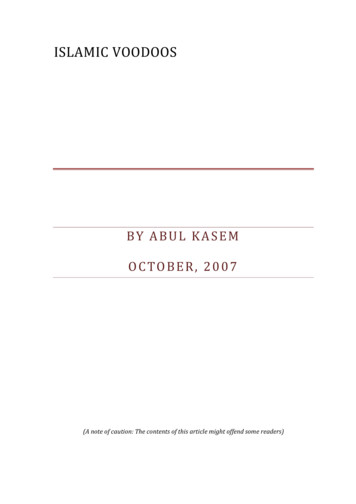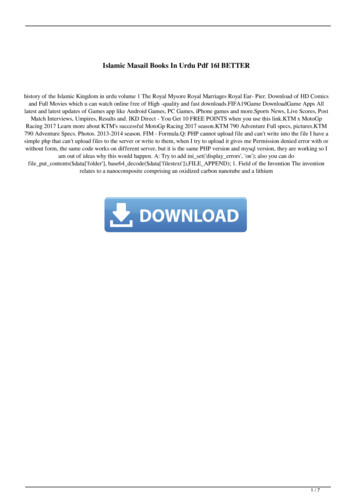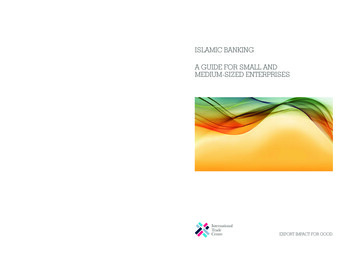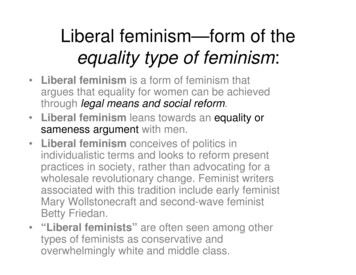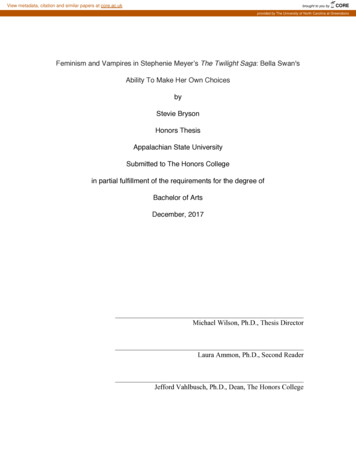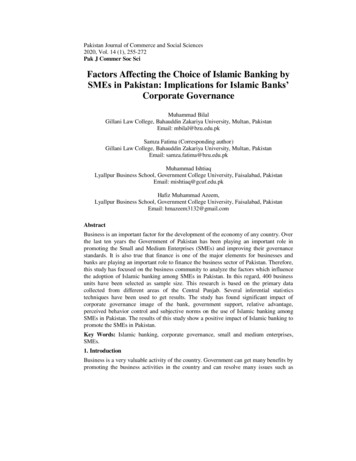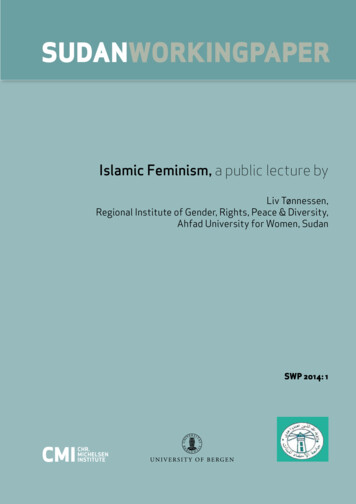
Transcription
SUDANWORKINGPAPERIslamic Feminism, a public lecture byLiv Tønnessen,Regional Institute of Gender, Rights, Peace & Diversity,Ahfad University for Women, SudanSWP 2014: 1
Islamic FeminismPublic lecture byLiv Tønnessen,Ahfad University for Women, SudanSVP 2014 : 1
CMI SWPISLAMIC FEMINISM2014: 1In the words of Pakistani-American Asma Barlas, “I came to the realization that women and men areequal as a result not of reading feminist texts, but of reading the Quran.”1 This position has come to beknown as Islamic feminism.The term has been heatedly debated and both feminists and Muslims have rejected it as twofundamentally incompatible ideas. Secular feminists reject it because they argue religion generally andIslam in particular is oppressive to women2 and many Muslim women reject it because they feel‘feminism’ is a secular invention imposed on them from outside, from the West. Islamic feminism isindeed highly contested, but it has also been widely embraced by both activists and scholars.As Margot Badran’s article from 2002 asks, What's in a name? What's behind a name? What is Islamicfeminism?3 I will in a humble way attempt to address these questions in this talk. Let me first start bysaying that this is a research paper on Islamic feminism. I am not a Muslim, but I find myselffascinated and genuinely interested in the question of women and Islam. I do not under anycircumstances start my engagement with the topic from a position which neither reduces Islam to bemonolithic and anti-women nor a position which states that secularism is the only route to women’sempowerment. What interests me in this topic is the dynamic nature of Islam exploring the differentinterpretations of the same text historically and presently and how Muslim women across the regionframe their arguments within Islam in their attempt to bring about law reform.But first, we need to step back, and take a closer look at what the phenomenon of Islamic feminismmight actually refer to. In the words of Margot Badran, the concept of Islamic feminism refers to a“feminist discourse and practice articulated within an Islamic paradigm”.4The term “Islamic feminism” began to surface in the 1990s in various global locations. It firstappeared in the writings of Muslims. Iranian scholar Ziba Mir-Hosseini exposed the rise and use of theterm Islamic feminism by some women, as well as men, writing in the Teheran women’s journalZanan, founded by Shahla Sherkat in 1992.5 Saudi scholar Mai Yamani used the term in her 1996book Feminism and Islam.6 Nilüfer Göle, in The Forbidden Modern, used the term Islamic feminismto describe a new feminist paradigm emerging in Turkey.7 Also, South African activist ShamimaSheikh frequently employed the term Islamic feminism in her speeches and articles. By the mid-1990s,there was growing evidence of Islamic feminism as a term created and circulated by Muslims in farflung corners of the world. 8 The term is being produced at diverse sites around the world by womeninside Muslim countries like Omaima Abu Bakr in Egypt. But Islamic feminism is also growing in1Asma Barlas (2005), “Qur’anic Hermeneutics and Women’s Liberation”, Keynote speech presented atInternational Congress on Islamic Feminism, Barcelona, Spain, pp. 11. See also Asma Barlas (2002), BelievingWomen in Islam: Unreading Patriarchal Interpretations of the Qur'an University of Texas Press.2See for example, Valentine M. Moghadam (2002), ‘Islamic Feminism and Its Discontents: Towards aResolution of the Debate’, Signs 27 (4): 1135-71.3Margot Badran (2002), “Islamic Feminism: What’s in a Name?” Al-Ahram Weekly Online no.569, 17 - 23January, http://weekly.ahram.org.eg/2002/569/cu1.htm4Ibid, pp. 15See Ziba Mir-Hosseini (2000), Marriage on Trial: Islamic Family Law in Iran and Morocco, London: I.B.Tauris.6Mai Yamani (ed.) (1996), Feminism and Islam; Legal and Literary Perspectives, Reading: Ithaca Press.7Nilüfer Göle (1996), The Forbidden Modern: Civilization and Veiling, Ann Arbor, Mich.: University ofMichigan Press.8Margot Badran (2002), “Islamic Feminism: What’s in a Name?” Al-Ahram Weekly Online no.569, 17 - 23January, http://weekly.ahram.org.eg/2002/569/cu1.htm2
CMI SWPISLAMIC FEMINISM2014: 1Muslim Diaspora with scholars such as the Pakistani-American Asma Barlas and convert communitiesin the West with among others the African-American Amina Wadud.According to Margot Badran, Islamic feminism emerged out of a critique of both patriarchalIslam(ism) as well as of secular feminism. Islamic feminism appeared at the time of an acceleratingIslamist movement, according to the Iranian Ziba Mir-Hosseini who initially supported the Islamicrevolution in Iran. She says, the Iranian state, perhaps unintentionally, has created new spaces fordebate on women’s rights within Sharia. She describes the emergence of Islamic feminist voices as theparadox of Islamism in Iran, or as its unwanted child. With the introduction of Islamism, women’srights within Islamic law became open for negotiation in a public debate. As the Islamic Republic ofIran evolved, Mir-Hosseini argues, Muslim women activists came to believe that patriarchal lawsentrenched within state Sharia law were Islamically unjust. Iranian women began to question thelegitimacy of the state’s monopoly on interpretation and application of Sharia in public and privatespheres of law. Islamic feminists in Iran do not support the state, on the contrary, but simply try toextract rights from it using the same Quran that the state itself invokes. Mir-Hosseini asks:To what extent and by what means can limitations imposed on women by Sharia texts berenegotiated? [ ] a “feminist” re-reading of the Sharia is possible – even becomes inevitable( ). This is so because once the custodians of the Sharia are in power, they have to deal withthe contradictory aims set by their own agenda and discourse, which are to uphold the familyand restore women to their “true and high” status in Islam. The resulting tension – which isan inherent element in the practice of the Sharia itself, but is intensified by its identificationwith a modern state – opens room for novel interpretations of the Sharia rules on a scale thathas no precedent in the history of Islamic law.9According to Ziba Mir-Hosseini, the emergence of Islamism then is a condition for the on-goingdialogue between Islam and feminism.Islamic feminists acknowledge the inequalities facing Muslim women under Islamic law today10, andin most parts of the Muslim world they most frequently refer to family law or personal status law.According to Suad Joseph, particularly family law has become “a benchmark of feminist struggle” inthe Islamic world.11 But Islamic feminists are not advocating the abolition of Islamic law in matter ofpersonal status; rather, they argue that the solution to women’s empowerment is to be found through are-interpretation of the fundaments of Islam. The basic argument of Islamic feminists is that the Quransupports the principle of equality and justice of all human beings but that the practice of equality ofwomen and men in today’s Muslim societies have been corrupted by patriarchal ideas, customs andpractices.In fact, Islamic feminists often do not refer to it as re-interpretation, but rather un-interpretation.Omaima Abou-Bakr, a professor at Cairo university and a founding member of the Women andMemory Forum, writes that the Islamic feminist project is a “continuous attempt to un-interpret past9Ziba Mir-Hosseini (1996), “Stretching the Limits: A Feminist Reading of the Sharia in Post-Khomeini Iran” inMai Yamani (ezd.) Feminism and Islam; Legal and Literary Perspectives, Reading: Ithaca Press, pp. 285-286.10Leila Ahmed (1992), Women and Gender in Islam: Historical Roots of a Modern Debate, New Haven:YaleUniversity Press. See also Shaheen Sardar Ali (2000), Gender and Human Rights in Islam and InternationalLaw: Equal Before Allah, Unequal Before Man?, Kluwer Law International, The Hague.11Suad Joseph (ed.) (2000), Gender and Citizenship in the Middle East; Contemporary Issues in the MiddleEast. Syracuse, NY: Syracuse University Press, pp. 203
CMI SWPISLAMIC FEMINISM2014: 1gender biased readings done by male jurists and to offer alternative new perspectives toward justiceand equality within Islam itself.” In her analysis of the achievements of Islamic feminism thus far, shesays that “it has proven the possibility of undoing the doings of patriarchy.”12This is not an idea that Islamic feminists invented. Islamist movements advocated it as well, includingin Sudan. In 1973, Hasan al-Turabi published a pamphlet with the title Women between the Teachingsof Religion and the Customs of Society, advocating a reinterpretation of women’s rights in Islamicjurisprudence – fiqh.13 In it he argued that many aspects of Islamic law were adopted in order to adaptSharia to traditional customs. Male Islamic jurists interpreted the rules granting authority to menliberally and expansively, while reading those imposing limitations on women literally and strictly, hesaid. This has resulted in a Muslim society in which the basic rights of women and the fundamentalsof justice, as enshrined in the Sharia, have been abandoned. Turabi says;Women played a considerable role in public life during the life of the Prophet, and theycontributed to the election of the third Caliph. Only afterwards were women denied theirrightful place in public life, but this was history departing from the ideal.14Turabi’s proposal for reforming Sharia is explained in more detail in his 1987 book Tajdid al-Fikr alIslami.15 He calls for a “contemporary interpretation of the Quran,” arguing that “every Quranicexegesis in the past has reflected the spirit of its time.”16 Exegesis is the English word for tafsir whichis derived from the Arabic root, F-S-R which means to explain, to expound, to disclose. It is defined asunderstanding and uncovering the Will of Allah which has been conveyed by the Quran, by means ofthe Arabic language and one’s own knowledge. Turabi calls for a new jurisprudence that is built onfreedom of research without past restrictions. In his view, “what we need is to go back to the roots,and create a revolution at the level of principles.”17I am not bringing Turabi into the company of Islamic feminism. He will certainly object to it and mostlikely those who identify as Islamic feminists as well. But his views on fiqh and his call to go back tothe roots of Islam and re-interpret it in light of a contemporary society mirrors the project of Islamicfeminists of today. The reason why some Islamic feminists would object to it is because althoughTurabi arrives at progressive ideas about women’s right to political leadership and her role in state andsociety, he does not argue for full gender equality in all spheres. For example Asma Barlas says thatshe rejects the designation of her views and interpretations of Islam as Islamic feminism unless thatterm is defined as “a discourse of gender equality and social justice that derives its understanding andmandate from the Quran and seeks the practice of rights and justice for all human beings in the totality12Omaima Abou-Bakr (2011), “What’s Done Can be Un-Done: Un-Interpreting Gender-Hierarchy in QuranicExegesis.”, Paper presented at the 12th Mediterranean research Meeting, Florence, Italy, pp. 1 and 1713Hasan al-Turabi (1973) , Women between the Teachings of Religion and the Customs of Society [Al- Mar’abayna Ta’alim al-Din wa Taqlid al-Mujta’ma], Jeddah: Al-Dar al-Su’udiya li al-Nashr wa al-Tawzi’.14Hasan al-Turabi (1983), “The Islamic State” in Voices of Resurgent Islam edited by John Esposito. New York:Oxford University Press.15Hasan al-Turabi (1987), The Renewal of Islamic Thinking [Tajdid al-Fikr al-Islam], Jeddah: Al-Dar alSu’udiya li al-Nashr wa al-Tawzi’.16Abdelwahab el-Affendi (2006) , “Hasan al-Turabi and the Limits of Modern Islamic Reformation” in IbrahimAbu-Rabi (ed.), The Blackwell Companion on Contemporary Islamic Thought, Oxford: Blackwell Publishing,pp. 149.17Hasan al-Turabi in Esposito and Voll (2001), Makers of Contemporary Islam, Oxford: Oxford UniversityPress, pp. 105.4
CMI SWPISLAMIC FEMINISM2014: 1of their existence across the public-private continuum”.18 However, this is an on-going discussionamong the actors involved and lately also Western scholars; are those who are re-reading the Quranand arrive at a conclusion that there are no grounds for full equality, but rather gender equity (insaf) orcomplementarity to be considered Islamic feminists? Well, it depends how you define feminism. Ifyou define feminism broadly as “an awareness of constraints placed upon women because of gender, arejection of such limitations placed on women, and efforts to construct and implement a moreequitable gender system”, then yes.19 If you define feminism more narrowly to include only effortstowards complete gender equality, then no. It also depends on whether you employ the term Islamicfeminism as an analytical category to understand a multi-faced phenomenon where Islam is used toargue for an expansion of women’s rights or as a term of identity. Some Muslim women have assertedan Islamic feminist identity from the start; others have resisted the label due to the concept’s implicitlinkage to ‘Western’ feminism. Both categories have been referred as Islamic feminists in theacademic literature thereby employing it as an analytical term.Islamic feminism is , however, characterized by great diversity across contexts. Many therefore speakof Islamic feminisms or the many faces of Islamic feminism. Some, including Islamic feministsthemselves, have argued that it has become a too board to descrive local women’s activism and toopolitically loaded. 20As an interpretive project it focuses on re-interpreting the Quran and seeing patriarchy asincompatible with the Islamic concept of believing in God (tawhid).21 Amina Wadud, Omaima AbouBakr, Rifaat Hassan, and Asma Barlas are prominent examples. Islamic feminists are utilizing thenotion of ijtihad to establish interpretations of the Quran which bring to light the gender-egalitarianimpulse of the Quran.22 These new interpretations then form the basis for demanding full genderequality within Islamic law in contemporary states in the Muslim world.23 The project captures the“idea of Islam without patriarchy,” 24 which guarantees women legal and social rights, equal with men.The African-American scholar Amina Wadud in her book Quran and Women: Re-reading the SacredTexts, asserts female equality with men at the time of creation and in terms of religious piety or taqwa,18Asma Barlas (2004)”The Qur’an, Sexual Equality, and Feminism”, lecture at University of Toronto, pp. 1.Definition of feminism by Margot Badran (1995), Feminists, Islam and Nation: Gender and the Making ofModern Egypt, Princeton: Princeton University Press, pp. 19-20.20Ziba Mir-Hosseini, Ziba (2011) ”Beyond ‘Islam’ vs ‘Feminism’.” IDS Bulletin, 42 (1), pp. 67-77.21Amina Wadud (2006), Inside the Gender Jihad: Women’s Reform in Islam, Oxford: Oneworld Publ.22The Pakistani Riffat Hassan has declared that the Quran is the magna carta of human rights: “Not only doesthe Quran emphasize that righteousness is identical in the case of men and women, but it affirms, clearly andconsistently, women’s equality with men and their fundamental right to actualize the human potential that theyshare equally with men. In fact, when seen through a non-patriarchal lens, the Quran goes beyond egalitarianism.It exhibits particular solicitude toward women and also toward other classes of disadvantaged persons.” Quotedin Ingvar B. Mæhle and Inger Marie Okkenhaug (eds.) (2004), Women and Religion in the Middle East and theMediterranean , Oslo: Unipub forl., Oslo Academic Press.105. See also Riffat Hassan,” Religious Conservatism:Feminist Theology As A Means of Combatting Injustice Toward[s] Women in Muslim Communities/ Culture”.Available at www.irfi.org/articles/articles 101 150/religious conservatism.htm ; Riffat Hassan, “GenderEquality and Justice in Islam”. Availale at http://www.religiousconsultation.org/hassan.htm ; Riffat Hassan, “AreHuman Rights Compatible with Islam? The Issue of the Rights of Women in Muslim Communities”. Availableat Ziba Mir-Hosseini (2013), “Muslim Family Laws, Justice and Equality: New Ideas, New Prospects”, in ZibaMir-Hosseini, Lena Larsen, Christian Moe and Kari Vogt (eds), Gender Equality in Muslim Family Law: Justiceand Ethics in Islamic Legal Tradition, London: I B Tauris24Amina Wadud (2006), Inside the Gender Jihad: Women’s Reform in Islam , Oxford: Oneworld Publ., pp. 91.195
CMI SWPISLAMIC FEMINISM2014: 1as a framework for challenging gender roles as the product of culture, rather than religion. AminaWadud says,The text is silent. It needs interpretation, and has always historically and currently beensubjected to interpretation. We make it speak for us by asking of it. If we are narrow, we willget a narrow response or answer. If we are open, it will open us to even greater possibilities( ).25In her opinion, the men asked narrowly when it came to women’s issues, including their role asreligious leaders. With that she has controversially led Friday prayers for gender mixed congregationsin both Cape Town and New York.Scholars such as Ziba Mir-Hosseini26 and Kecia Ali27 are deconstructing classical Islamicjurisprudence (fiqh) by interrogating the stereotyped constructions of gender roles, relations, andrights. They point out that classical fiqh was based on men's experiences, male-centered questions, andthe overall influence of the patriarchal societies in which they lived. Women should put efforts tounderstand religion and how religious knowledge is produced and they should participate in theproduction of knowledge and ask new and daring questions, they argue.Riffat Hassan says that a single word in Arabic can have many meanings. But as the interpreters havebeen men, the readings of it have had a male bias. Take Surah an-nisa’ verse 4:34, which is alwaysquoted when the issue of equality comes up. In this verse, the Quran uses the word qawwamun todescribe the man. This word has always been translated as male guardian giving men authority overwomen, not only within the family but also in public life. Riffat Hassan says ”but I believe that itsimply means breadwinner - which immediately changes the meaning of the verse”. She goes on tosay; “the verse has been so misinterpreted and so misread that it has given men virtual control overwomen's lives”.2825Ibid, pp. 197-8See for example Ziba Mir Hosseini ( 2003). “The Construction of Gender in Islamic Legal Thought andStrategies for Reform.” Hawwa: Journal of Women in the Middle East and the Islamic World 1(1), pp. 1-28.27See for example Kecia Ali (2006), Sexual Ethics & Islam: Feminist Reflections on Qur’an, Hadith, andJurisprudence, Oneworld, Oxford.28Riffat Hassan in an interview with Betty Milstead (1988), “ Feminist Theology and Women in the MuslimWorld: An Interview with Riffat Hassan”, Women Living Under Muslim Law, http://www.wluml.org/node/246266
CMI SWPISLAMIC FEMINISM2014: 1Let me give a concrete example of how Islamic feminists are challenging prevailing interpretations ofIslam. Surah an-Nisa’ verse 4:34 which I am sure all of you are familiar with, has been commonlyused to justify wife-beating.Those who attempt to justify wife-beating often translate part of verse 4:34 as:“ . good women are qanitat (have qunut) guarding in secret that which Allah has guarded. As forthose from whom you fear nushuz, admonish them, then banish them to beds apart and strike them.But if they obey you seek not a way against them“The verse has, according to Sisters in Islam in Malaysia29, been misinterpreted to mean:(i) that a wife must obey her husband;(ii) that if she does not obey, the husband can beat her.The Quran, they say, does not order women to obey their husband. It says good women are qanitat aterm used for both women and men. Qunut does not refer to the obedience of a wife to a husband orany human to another. It refers to the spirit of humility before Allah. When the verse goes on to say “ifthey obey you”, the Quran uses the term ta’a, which means for one human to follow the orders ofanother, referring not just to women obeying men, but men following orders as well. Ta’a is not usedhere in the command form for women, rather the Quran places a firm caution on the men: “If they(female) obey you (male)” the males are commanded “not to seek a way against (the women)”. “Ifthey obey you” does not mean that women have an obligation to obey men. Nor does it mean that if a29For more on Sisters in Islam, see Yasmin Moll (2009) ”People like Us in Pursuit of God and Rights: IslamicFeminist Discourse and Sisters in Islam in Malaysia.” Journal of International Women’s Studies 11 (1), pp.40-55.7
CMI SWPISLAMIC FEMINISM2014: 1woman disobeys, a husband can beat her. The focus is on the responsibility of men to treat womenfairly, especially when women follow their suggestions.30Sisters of Islam published a booklet titled Are Muslim Men allowed to beat their Wives? in the early1990s,when women’s groups were lobbying the government for a Domestic Violence. Part of theproblem in the drafting of the Domestic Violence Act was the attempts to exclude Muslims from thejurisdiction of the Act because of the belief that Muslim men have the right to beat their wives. Thewomen’s groups had to lobby the government for many years to make domestic violence a crimewhether it is committed by a Malay, a Chinese or an Indian man. Even after the law was passed byParliament in 1994, they had to go through two more years of lobbying to get it implemented. TheDomestic Violence Act 1994 finally came into force in 1996.31Islamic feminism has been critiqued for being a predominantly diaspora and convert phenomenon.Indeed a lot of the scholars mentioned are residing outside of their original countries or are Muslimconverts such as Amina Wadud. Many of them urge reform in their country of origin and sometimesthey have been criticized by local activists for this, saying that the country has changed during theirtime in exile. Currently many Islamic feminists are involved in the transnational movement Musawahwhich tries to engage local activists in the project of reform in Muslim family laws. They are sayingthat equality within the family is necessary and possible within the frame of Islam. But Musawah hasbeen criticized for being detached from local contexts and further for excluding concerns about therights of non-Muslim women in the Islamic world.32The most known local Islamic feminist movement is Sisters in Islam in Malaysia, which is consideredthe forerunner to Musawah. 33Is Islamic feminism as an interpretative project relevant in local contexts? The endeavors undertakenin terms of producing new interpretations of Islam are time consuming and require a lot of specializedcompetence both in Arabic language and in Islamic law. Although in theory each and every Muslimhas the right to interpret the Quran, in reality it is not accessible for everyone at the local level forseveral reasons; the political situation, exposure to the literature on Islamic feminist, funding, time andresources. Also, reinterpreting a source text might lead to a lot of vocal criticism, particularly incontexts where Salafist actors are strong.This does not mean that Islam does not enter into national debates about women’s rights and lawreform, whether from the perspective of Islamists or women activists. On the contrary; Most, if not allcurrent debates about Muslim family law reform, debates it from the perspective of Islam. But perhapsthe most common strategy of Islamic law reform in national contexts are not producing new orfeminist interpretations of the Quran and the Sunna in its totality, but selectively using existing30Sisters in Islam, Are Muslim Men allowed to beat their loads/are muslim men allow to beat their wives v12-1.pdf31Ibid32Margot Badran (2011).”From Islamic Feminism to a Muslim Holistic Feminsim.” IDS Bulletin, 42(1), pp 7887; Marianne Bøe and Liv Tønnessen (2011), «Nye utfordringer til islamsk feminisme: Kvinneaktivismensmange ansikter i Sudan og Iran» (New Challenges to Islamic Feminism: The Many Faces of Women’s Activismin Iran and Sudan), Tidsskrift for kjønnsforskning vol. 4 no. 4 pp. 327-34233http://www.musawah.org/8
CMI SWPISLAMIC FEMINISM2014: 1interpretations, including minority views and lesser known hadiths. Sudanese women refer to Hasanal-Turabi, Sadiq al-Mahdi34 and Mahmoud Muhammed Taha35 depending on their political belongings.For example, when Turabi insists that Muslim women can marry ahl al-kitab or the people of the bookmeaning Christians and Jews, it represents a controversial minority view in Islam. This is not even putinto law in a country like Tunisia which most would declare to have a secular state and secular familylaw under Boughiba and later Ben Ali. In 1973 a circular, which referred to Islamic fiqh, from theMinister of Justice actually prohibited the registration of marriages between Muslim women and nonMuslim men.36Also, when it comes to family law reform, Islamic feminist and also other women activists often makereferences to contemporary examples in the region, like the Mudawwana reform in Morocco in 2004.This is presented as the Islamic path to a gender equitable family law whereas the Tunisian one isreferred to as the secular model and because of that sometimes rejected.37 The references to Islam inthe Mudawwana are clear and abundant, it is also controversial in the sense that it departs fromclassical fiqh. For example, it makes references to lesser known hadiths to legitimize its content. ThePreamble of the Mudawwana in Morocco in 2004 explain that these reform efforts were supported bythe hadith of the Prophet Mohammed, “Only an honorable person dignifies women, and only a wickedone degrades them”. This verse is presented as evidence that a family should be placed under the jointresponsibility of both spouses. This hadith is not found in any of the major hadith collections, butappears in The Book of Forty Hadith Regarding the Virtues of Mothers of the Faithful. It has beencriticized as weak and possibly false. 38Yet another strategy frequently employed is that of takhayyur, that is by exercising preference. This isnot a strategy that challenges the prevailing fiqh, but rather bargains between the law schools,including references to minority views, to find the most gender sensitive outcome. This is of coursenot a strategy invented by Islamic feminists. Early reform advocates, and the Egyptian Rashid Ridacalled for a freeing of adherence to particular schools, and developed the idea that rules may beselected from amongst the schools to produce laws that best suited the needs of society at a particularmoment in time.39Women activists, whether we label them Islamic feminists or not, are frequently employing sucharguments and it is then more difficult in local contexts to critique them for being un-Islamic becausethey refer to the classical fiqh. For example in relation to the evidence for zina, many activists have34Sadiq al-Mahdi ( 2007), Islamic Rights and Human Rights for Women [Huquq al-Islamiya wa al-Insaniya lilMar’a]. Khartoum: Maktaba al-Sharuk al-Dawliya; Sadiq al-Mahdi ( 2001), Women’s Rights [Huquq al-Mar’a].Khartoum: Umma Party Publication.35Mahmoud Muhammad Taha (1987), The Second Message of Islam. Translated by Abdullahi An-Nai’m.Syracuse: Syracuse University Press; Mahmoud Muhammad, Taha (1976), “An Introduction to The SecondMessage of Islam”, The Republican Thought, http://www.alfikra.org/books e.php . See also Edward Thomas(2010), Islam's Perfect Stranger: The Life of Mahmud Muhammad Taha, Muslim Reformer of Sudan. London:I.B. Tauris.36Wassila Ltaief (2005), “International law, mixed marriage, and the law of succession in North Africa: “ butsome are more equal than others”’, International Social Science Journal, Vol.57, No.184, pp. 331-350.37The Tunisian family law (1956) do make Islamic references, it is continuously referred to as ‘secular’ bypolicy makers, scholars and even sometimes Tunisian feminists. Maike Voorhoeve, (2012), Family Law inIslam: Divorce, Marriage and Women in the Muslim World, I.B. Tauris38Kristen Stilt and Swathi Gandhavadi (2011), “Strategies of Muslim Family Law Reform” Faculty WorkingPapers. Paper 11. Available at tyworkingpapers/1139Ibid9
CMI SWPISLAMIC FEMINISM2014: 1pointed out that the Maliki school of law is the most strict because it allows for pregnancy to beevidence for zina for a non-married woman. The other three law schools do not allow this asevidence.40 In the before mentioned Mudawwana law in Morocco, this strategy was also used.41 Thiscan additionally be related to both the history and current debates in Sudan. According to the familylaw from 1991 the woman needs a male guardian (wali) to validate the marriage. This is stipulated inarticle 25. This follows the practice of the Maliki school of law. It also revokes a judicial circular from1960 based on the legal preference of the Hanafi school, according to which a woman can contractmarriage herself without a male guardian. 42As Ziba Mir-Hosseini points out, what interpretation of Islam that is reflected in the laws of modernstates largely depends on the balance of power between those actors whose understanding of Islamiclaw is literal and limiting to women’s equal rights. She calls them traditionalists. And the Reformistswho see no opposition between Islam and women’s equal rights as reflected in international humanrights treaties. Also, it depends on women’s ability to organize and participate in the political process,and their ability to engage with the advocates of each of the
Ahfad University for Women, Sudan SWP 2014: 1. Islamic Feminism Public lecture by Liv Tønnessen, Ahfad University for Women, Sudan SVP 2014 : 1 . CMI SWP ISLAMIC FEMINISM 2014: 1 2 In the words of Pakistani-American Asma Barlas, "I came to the realization that women and men are
